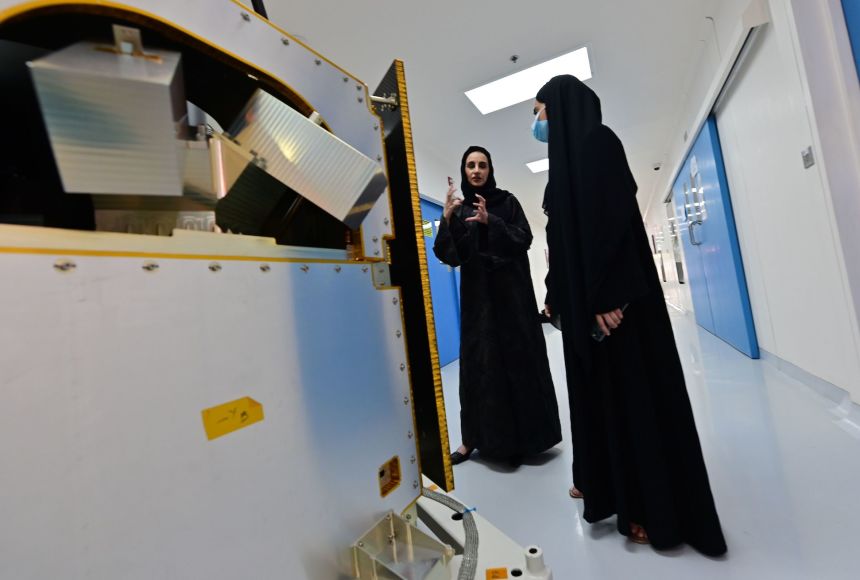Mai Elshehaly was attending a conference in the United States when the presenter showed a photograph of women in traditional dress as an example of social oppression. The Egyptian-born Elshehaly acknowledged this perspective about her birth region in the June 2020 issue of the science journal Nature Middle East. “I wished they were informed about the millions of brilliant Arab women fighting against prejudice and stereotyping at home and around the world,” Elshehaly countered. “This is why we can’t just stop at saying that the representation of women in STEM matters, but we must explain that it matters in different ways to the diverse communities in STEM.”
Elshehaly is helping to diversify STEM, or science, technology, engineering and mathematics. As a computer science lecturer at the United Kingdom’s University of Bradford, she represents another type of story about women in North Africa and the Middle East. So does Sarah Al-Amiri. The chair of the United Arab Emirates (UAE) Space Agency and the Emirati minister of state for advanced sciences led the successful operation of the Hope Probe. Built by the UAE, it reached Mars orbit carried by a Japanese-made rocket on February 9, 2021. The Middle Eastern country became only the fifth nation (and first Arab one) to successfully orbit a satellite around the red planet. Al-Amiri’s achievement was a huge step for women, and especially women of Arab descent. But these are not isolated achievements.
Women make up 80 percent of the Hope Probe mission’s scientists. This may appear counterintuitive. The region is often perceived as a place where women’s rights are restricted relative to much of the rest of the world. Some of this bears out with many of these nations ranking near the bottom of the 2019 Women, Peace and Security Index. But like the photograph Elsehaly saw at the conference, this doesn’t tell the whole story.
At the university level, women in North African and Middle Eastern nations comprise nearly half, and sometimes more, of STEM students. Women in many Middle Eastern and North African nations graduate with university degrees in STEM, often at higher rates than their U.S. and European counterparts.
Women in North Africa and the Middle East even earn STEM degrees at relatively high rates in the notoriously male-dominated disciplines of engineering and computer science. This hasn’t always been the case. Some of the first computer scientists were women. These jobs were considered technical positions and didn’t garner the prestige of an engineer. (Many of these innovators were called computers—see NASA’s West Area Computers.) Patriarchal norms, the systemic privileging of men, saw these roles then switch from mostly women to men when they became more prestigious and better paid.
Women in the Middle East and North Africa graduate with engineering degrees at much higher rates than the United States, where women earn just over 20 percent of engineering bachelor’s degrees. This is especially pronounced in the Gulf States, where women comprise about 60 percent of engineering students.
National wealth, or lack thereof, can’t explain these trends. Both high-income and less affluent nations in the Middle East and North Africa have relatively large numbers of women studying STEM. There is at least one theory as to why women in these countries with less gender equity show better gender parity in STEM degrees. In these places, there is no deep-seated belief that boys are innately better at math and science than girls. This enables girls and women to enter STEM without the same level of social pressure and self-doubt often found in other places.
This is not to say that North Africa and the Middle East have created gender parity in STEM, as employment outcomes still lag for women working in STEM. Women in the region account for just 40 percent of the STEM workforce. However, these nations fare better than most. The only regions with higher percentages of female STEM researchers are Central Asia and Latin America and the Caribbean. Overall, less than 29 percent of researchers are women, according to data from the UNESCO Institute for Statistics.
The disparity between women in North Africa and the Middle East earning degrees in STEM and working in the field may have little to do with STEM itself. Women in the Middle East and North Africa have the world’s lowest rate of work force participation. Many women in the region are not employed, even after obtaining a university degree, regardless of field. Women not entering the workforce may be due to cultural norms, which limit interactions between men and women.
The story of women in the Middle East and North Africa is not a simple one, but it is one worth telling. Elshehaly concurs: “Many years ago while attending a professional development seminar, I discovered that I was ill-equipped to explain why I strongly felt that women in Egypt did not have equal career opportunities despite being informed that the percentage of women enrolled in and graduating with degrees in STEM fields in the Arab region is relatively high.”
